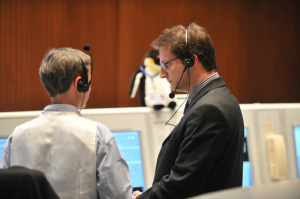We received a note on Monday, 31 January, from ESA’s Daniel Firre from the ATV Operations Management Team who was here at ESOC in Germany working with the ESTRACK ground station experts to conduct a pre-launch test of the ATV proximity communication system. The system provides a direct radio link between ATV and the Russian Zvezda service module of the ISS.
Monday’s test included transmitting a signal from the ISS in space to ESA’s 15m stations located at Maspalomas and Villafranca, Spain, a space-to-ground distance of some 350 km.
Compare this to a separate test last week with the ATV, which involved using the proximity communication transmitter on board ATV to transmit a live radio signal over the air from ATV mounted on top of Ariane 5 (in Kourou) to ESA’s 15m ground station that is also in Kourou – a distance of just a few kilometres! See: ‘Telemetry received from ATV via ESA tracking station‘
Now, both proximity radio units – one on board the ISS and one on board ATV – have successfully contacted ESA tracking stations. And both the primary and back-up modes have been confirmed. As Daniel wrote: “The success of today’s test lit another green light for launch on 15 February.”
Access full details after the jump.
However, the two tests were somewhat different.
Monday’s test was aimed at ensuring direct communications between ATV-2 and the ISS – and the ESA ground stations in Spain and Belgium were used to validate the technical operation of the proximity communications. On the other hand, the end-to-end test last week at Kourou aimed at validation of a backup scenario in which ATV could be commanded from ATV-CC if all normal communication methods were to fail.
The main hardware of the proximity communication system is a self-contained electronic unit, the Proximity Communication Equipment (PCE); there is one mounted inside both ATV and in the ISS. The 55-kg PCE unit mounted inside the Zvezda module arrived in space via a Progress resupply mission in March 2005. It communicates by radio via two antennas mounted on the outside of the ISS with the two similar antennas mounted on ATV, one directly on the side of the vessel and another on a deployable boom.
“The PCE is part of the direct radio link between ISS and ATV and is required for the final phase of the rendezvous and docking. It is through this interface that the ISS crew can quickly react to unexpected deviations from the nominal rendezvous and docking approach by issuing a radio command to ATV – to hold, perform an escape or abort the docking,” said Firre.
Firre explained that Monday’s PCE test is a critical step in ATV launch preparations – until the link is confirmed, ATV cannot launch.
On Monday, during several overhead orbits of the ISS, the proximity communication equipment in space correctly transmitted signals from the ISS to ESA’s two ground stations in Spain. In previous test transmissions, the ISS had to perform a tilt manoeuvre so as to orient the rear-most Russian module – where the transmitting antennas are located – to point vertically towards the Earth over the ESA stations. But Daniel says that this week, “The ISS was not tilted to a special attitude. It was discovered during similar tests in October 2010 that changing the attitude of ISS for testing the PCE antennas is not required, which is a great simplification of the whole procedure!”
On 11 January, in preparation for today’s test, Russian cosmonaut Alex Kaleri worked for several hours to prepare the PCE for use (it is normally disconnected and stowed between ATV missions). This included laying out cabling and installing the electronic control boxes that comprise the PCE. On Earth, Monday’s test involved experts from ESA, NASA and Russia’s RSC Energia.
More info:
ISS/ATV communication system flight on Soyuz via SpaceRef.com


 Automated Transfer Vehicle page
Automated Transfer Vehicle page ATV blog archive
ATV blog archive
 NASA Orion page
NASA Orion page NASA Artemis
NASA Artemis Airbus Orion page
Airbus Orion page
Discussion: no comments